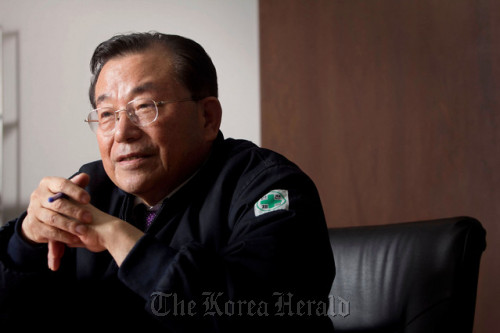South Korea is pushing to include the Gaeseong industrial zone in North Korea in its free-trade deals with the U.S. and Europe, a step that would deepen cross-border ties after the North’s leadership transition.
“Unification is already taking place in Gaeseong, with daily encounters and shared interests,” said Yoo Dong-ok, the chairman of Daewha Fuel Pump Industries and a spokesman for South Korean companies operating in the manufacturing enclave. Shipments from the factories, mostly textiles and car parts, would quickly surge 15 percent if they win free-trade status, Yoo estimated in a March 20 interview.
Yoo and the government in Seoul want the fruits of North Korean workers’ labors on the shelves of stores in Chicago and Berlin, even as they condemn the regime of new leader Kim Jong Un for a planned rocket launch. The U.S. warned the test-firing jeopardizes a food-aid deal and breaks international agreements.
“It may help any efforts by North Korea to open up if the South wins inclusion for Gaeseong,” said Cho Bong-hyun, a researcher at IBK Economic Research Institute in Seoul who has visited the communist country more than 30 times since 2000 and advises companies seeking to do business there. “North Koreans have lived in a closed society under tight state control but now through Gaeseong, they’re learning about and experiencing the outside world.”
 |
Yoo Dong-ok, chairman of Daewha Fuel Pump Industries and a spokesman for South Korean companies operating in the Gaeseong industrial zone in North Korea (Bloomberg) |
Gaeseong, which is within sight of South Korean and U.S. guard posts along the Demilitarized Zone, was developed as a joint special economic zone in 2005 and now employs about 50,000 North Koreans, according to the Unification Ministry in Seoul.
Hard currency
More than 120 South Korean companies, including Daewha Fuel, underwear maker Good People Co. and watchmaker Romanson Co. paid the North Korean government about $60 million to $70 million last year to cover labor costs for workers, said Park Soo Jin, the deputy spokeswoman at the Unification Ministry. Authorities in Pyongyang then paid the employees in local currency and vouchers, she said.
Trade Minister Bark Tae-ho said on March 14 that he will try to persuade the U.S. and European Union to recognize products made in Gaeseong as South Korean.
The EU and South Korea have agreed to establish a committee this year to examine the issue, Tomasz Kozlowski, ambassador for the EU delegation in Seoul, said in an e-mailed statement. Aaron Tarver, a spokesman at the U.S. Embassy, said in an e-mail that the trade pact does not include any products from North Korea, including those from Gaeseong, without commenting further.
Singapore tariffs
Singapore has reduced tariffs covering more than 4,000 products from Gaeseong under its bilateral trade pact with South Korea, said Lee Sang-mok, Deputy Director at Korea Customs Service. Some products are also covered by agreements with the 10-member Association of Southeast Asian Nations, India, Peru and the European Free Trade Association consisting of Switzerland, Iceland, Liechtenstein and Norway, Lee said via e- mail and telephone.
The value of output from Gaeseong jumped from $14.9 million in its first year to $402 million in 2011, according to the Unification Ministry. During the past seven years, its production totaled $1.5 billion. That compares with $40 billion for North Korea’s annual gross domestic product, according to the CIA World Factbook.
“The U.S. seems to want more progress in North Korean nuclear and human rights issues before including Gaeseong in FTA,” IBK’s Cho said.
Rocket tests
Next month’s announced rocket launch, which North Korea said will be used to put a satellite into orbit, follows an agreement in February to halt nuclear and missile tests in exchange for U.S. food aid. The totalitarian state defied the United Nations in 2009 by firing a rocket and saying the launch was a satellite test, the same year it detonated a second nuclear device.
“Gaeseong is currently the only way South Korea has into the North,” Kim Choong-hwan, chairman of parliament’s Foreign Affairs, Trade and Unification Committee, said in Feb. 20. “It is the only thing that is of mutual interest and benefit to both Koreas and a good reminder of how we can coexist.”
Kim estimated that the economic zone’s operations could expand more than 20 times within five years, if political and diplomatic tension between the Koreas eases.
Yoo of Daewha Fuel Pump said he plans to spend 1 billion won ($885,000) this year to boost capacity in Gaeseong by 50 percent and forecasts sales to jump to 65 billion won this year from 45 billion won in 2011. His company, which also makes parts in plants in South Korea, supplies automakers including Hyundai Motor Co., Honda Motor Co. and Nissan Motor Co., he said.
The minimum monthly base salary paid by companies at Gaeseong is about $64, according to the Unification Ministry’s Park. Yoo, who was speaking at Incheon near Seoul, estimated labor costs would be 20 times higher in South Korea and three times higher in China.
“The security issue is of course a big risk but every business has a risk,” Yoo said. “Gaeseong has survived all the clashes and threats, including the sinking of a warship and the shelling of a South Korean island.”
(Bloomberg)








